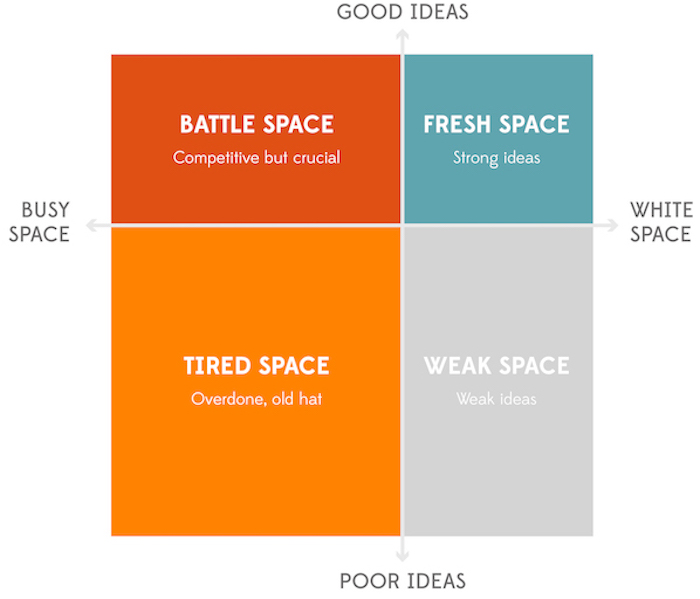From bandwagon to battle space: How to choose the right thought leadership topic
Ben Harrison
Focus on the insights and knowledge your audiences need, and the issues they want to know more about, and your thought leadership is more likely to achieve its goals.
It sounds so simple, doesn’t it? But this advice is frequently ignored.
In our experience, people who create thought leadership often launch straight into their idea without identifying any need for it among their audiences. To make matters worse, they often choose a topic that is well-trodden and overexposed.
Safe spaces: Where are the best ideas?
Instead of coming up with an entirely fresh, valuable idea, or pursuing something that might be a crowded field but is too crucial to ignore, they are retreating to easier options: ideas that are stale, mediocre and overdone. Their content occupies the bottom two quadrants in the diagram below – it should be in the top two.

Why is this happening?
Budgets in B2B marketing are often tight, so priorities in terms of where to invest have to be considered carefully. Brands often overlook or short cut thought leadership strategy in the rush to take their content to market, but it’s a vital component of any campaign: setting clear objectives, aligning the expectations of internal stakeholders and fully understanding the needs of the market will always pay off.
Hot or not?
Our survey of nearly 1,000 senior business leaders gives a good indication of what thought leadership audiences are looking for. Our topics heatmap helps you to see at a glance which topics are hot on the corporate agenda – and which are not. The findings might surprise you.
1. Strategic themes win the day
Business leaders are most interested in thought leadership that covers business strategy: 43% want to read about it, which is more than double the number that want to read about technology (20%), operations (19%) and the business environment (18%).
A lot of companies are publishing reams of content on technology, but while tech will remain in the limelight (see below), our research shows that if you want to reach C-suite audiences you will have to elevate the story to a more strategic level.
Percentage of respondents
2. Common topics are losing ground
There is now limited demand for thought leadership on corporate social responsibility and mergers & acquisitions. Content on corporate sustainability might struggle to engage a broad business audience, as this too comes low on the list of topics.
Of course, there will always be executives who do need insight in these areas. But if you want to connect with a wider C-suite audience, then you will need to seek out topics that are higher up the strategic agenda.
3. Tech trends battle for top spot
A great deal of thought leadership today covers trends in new technologies, and our research shows that the internet of things has overtaken artificial intelligence as the tech to watch.
Anecdotally, all the hype is around AI and machine learning, but only 38% of business leaders want more insight on these topics. Many more (51%) are hungry for content that deals with the IoT. And even more popular than the tech itself are topics related to cyber risk (53%) and digital business models (60%).
4. Client experience is a top priority
The technological advancements of the past decade have expanded the services firms can offer. Services such as cloud, autonomous databases and the IoT are all becoming the main breadwinners for Silicon Valley’s tech giants – for example, end-user spending on IoT solutions is due to increase by a factor of seven by 2025. But opportunities for differentiation are rare.
So brands are now turning to their customer experience (CX) teams to give them a new competitive advantage: CX and customer service is the topic that senior business leaders most want to learn more about (69%). Reports such as Verizon’s Winning the CX War will give brands an edge, and this is unlikely to change any time soon.
For more detailed analysis of 27 topic areas and the appetite for them across a range of C-suite roles in a variety of sectors, explore our interactive topics heatmap here.
Don’t assume you know what they want
So unless you put in the time to find out whether your chosen topic is likely to resonate – whether it’s for a new project or a repeated one – your programme is at an immediate disadvantage.
Our advice is this: be clear on who your audience is, then do the research to identify their needs. That way, you’ll get your topic right first time.
Speak to the team
We’ll help you to navigate and overcome any challenges you currently face and learn how to get more out of your content.
Book a meeting
About the author: Ben Harrison
As Digital Marketing Manager, Ben leads various marketing activities such as the firm’s social media effort, our always-on content programme, and all aspects of the website – from maintenance to re-designs. He also manages the department’s tech stack, delivering an increasingly seamless experience from marketing all the way through to the sales team.
Ben also contributes to the marketing team’s overall strategy and goals, helping to plan, execute and effectively measure all our content and engagement that push the firm towards brand- and commercial-oriented goals.
 |
Tel:
+44 (0)20 7873 4770
|
Tel:
+44 (0)20 7873 4770


